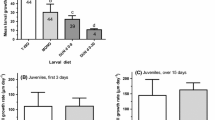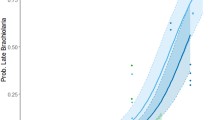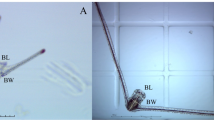Abstract
Effects of larval and algal culture density and diet composition on development and survival of temperate asteroid larvae were studied in the laboratory at Santa Cruz, California, USA, during summer and fall of 1990. Larvae of Asterina miniata were reared at two densities, 0.5 or 1.0 ml-1, and fed one or two species of cultured phytoflagellates — Dunaliella tertiolecta alone or mixed with Rhodomonas sp. — at three concentrations of 5x102, 5x103, and 5x104 total cells ml-1. Algal concentration strongly influenced larval development; however, larval density also had a marked effect. Development progressed further with increasing algal concentration. Larval growth and differentiation were sometimes uncoupled; i.e., growth measures were directly related to food level, while differentiation indicators were less so. At the lowest food level, growth was negative and differentiation was arrested at early precompetent stages; these larvae never formed juvenile rudiments or brachiolar attachment structures. Development times of larvae given more food ranged from 26 to 50 d and depended directly on food availability. Development time to metamorphosis at the highest food concentration was similar for siblings fed D. tertiolecta alone or mixed with Rhodomonas sp. In contrast, when food level was an order of magnitude lower, larvae fed the algal mixture metamorphosed significantly earlier than larvae fed the unialgal diet. This suggests interactive effects of food quantity and food quality. Survival was little affected by larval or food density, except at the lowest ration. Feeding experiments in well-controlled laboratory conditions are useful to predict and compare the physiological or developmental scope of response of larvae to defined environmental factors; however, results from such studies should not be extrapolated to predict rates and processes of larval development in nature.
Similar content being viewed by others
References
Allen EJ, Nelson EW (1911) On the artificial culture of marine organisms. J mar biol Ass UK 8: 421–474
Allison GW (1994) Effects of temporary starvation on larvae of the sea star Asterina miniata. Mar Biol 118: 255–261
Basch LV (1992) Variation in echinoderm larval nutrition: consequences for pre- and early post-settlement life history stages. Am Zool 32: p. 110A
Basch LV (1993) Nutrition and the ecology of some marine invertebrate early life history stages. Doctoral dissertation. University of California, Santa Cruz
Bayne BL (1965) Growth and delay of metamorphosis of the larvae of Mytilus edulis. Ophelia 2: 1–47
Bell JL (1993) Feeding and growth of prosobranch veligers. Doctoral dissertation. University of Hawaii, Honolulu
Bosch I, Pearse JS, Basch LV (1990) Particulate food and growth of planktotrophic sea star larvae in McMurdo Sound, Antarctica. Antarctic J US 25: 210–212
Cameron RA (1981) Some features of the larval and settlement stages of the sea star, Patiria miniata. Am Zool 21: 988
Chia F-S, Walker CW (1991) Echinodermata: Asteroidea. In: Giese AC, Pearse JS, Pearse VB (eds) Reproduction of marine invertebrates. Vol. 6. Echinoderms and lophophorates. Boxwood Press, Pacific Grove, California, pp 301–340
Davis HC, Guillard RR (1958) Relative value of ten genera of microorganisms as foods for oyster and clam larvae. Fish Bull US 58: 293–304
Fenaux L (1982) Nutrition of larvae. In: Jangoux M, Lawrence JM (eds) Echinoderm nutrition. Balkema, Rotterdam, pp 479–489
Fenaux L, Cellario C, Rassoulzadegan F (1988) Sensitivity of different morphological stages of the larva of Paracentrotus lividus to quantity and quality of food. In: Burke R, Mladenov PV, Lambert P, Parsley RL (eds) Echinoderm biology. Balkema, Rotterdam, pp 259–266
Fritz LW, Lutz RA, Foote M, Van Dover CL, Ewart JW (1984) Selective feeding and grazing rates of oyster (Crassostrea virginica) larvae on natural phytoplankton assemblages. Estuaries 7: 513–518
Gallager SM, Mann R (1981) The effect of varying carbon/nitrogen ratio in the phytoplankter Thalassiosira pseudonana (3H) on its food value to the bivalve Tapes japonica. Aquaculture, Amsterdam 26: 95–106
Guillard RL (1975) Culture of phytoplankton for feeding marine invertebrates. In: Smith WL, Chanley MH (eds) Culture of marine invertebrate animals. Plenum Press, New York, pp 29–60
Hansell DA (1993) Results and observations from the measurement of DOC and DON in seawater using a high-temperature catalytic oxydation technique. Mar Chem 41: 195–202
Hinegardner RT (1969) Growth and development of the laboratory cultured sea urchin. Biol Bull mar biol Lab, Woods Hole 137: 465–475
Hobbie JE, Daley RJ, Jasper S (1977) Use of Nuclepore filters for counting bacteria by fluorescence microscopy. Appl envirl Microbiol 33: 1225–1228
Hoegh-Guldberg O, Pearse JS (1995) Temperature, food availability, and the development of marine invertebrate larvae. Am Zool 35: 415–425
Kinne O (1977) Cultivation of animals: research cultivation. In: Kinne O (ed) Marine ecology — a comprehensive, integrated treatise on life in the oceans and coastal waters. Vol. 2. Wiley-Interscience, New York, pp 579–1293
Langdon CJ, Waldock MJ (1981) The effect of algal and artificial diets on the growth and fatty acid composition of Crassostrea gigas spat. J mar biol Ass UK 61: 431–448
Lawrence JM, Fenaux L, Jangoux M (1977) Qualitative nutritional requirements of echinoderm larvae. In: Recheige M (ed) CRC handbook series in nutrition and food. Ser. D. Vol. 1. CRC Press, Cleveland, pp 401–407
Loosanoff VL, Davis HC (1963) Rearing of bivalve mollusks. Adv mar Biol 1: 1–136
Lucas JS (1982) Quantitative studies of feeding and nutrition during larval development of the coral reef asteroid Acanthaster planci (L). J exp mar Biol Ecol 65: 173–193
MacBride EW (1914) Textbook of embryology. Vol. I. Invertebrata. Macmillan, London
Metschnikoff E (1870) Studien uber die Entwicklung der Echinodermen und Nemertinen. Zap imp Akad nauk Ser 7, 14(8): 1–73
Mortensen T (1921) Studies of the development and larval forms of echinoderms. GEC Gad, Kobenhavn
Olson RR (1987) In situ culturing as a test of the larval starvation hypothesis for the crown-of-thorns starfish, Acanthaster planci. Limnol Oceanogr 32: 895–904
Olson RR, Olson MH (1989) Food limitation of planktotrophic marine invertebrate larvae: does it control recruitment success? A Rev Ecol Syst 20: 225–247
Parsons TR, Maito Y, Lalli CM (1984) A manual of chemical and biological methods for seawater analysis. Pergamon Press, New York
Pearse, JS, Bosch I, Pearse VB, Basch LV (1991a) Bacterivory by bipinnarias: in the Antarctic but not in California. Am Zool 31: p. 6A
Pearse JS, Bosch I, Pearse VB, Basch LV (1991b) Differences in feeding on algae and bacteria by temperate and antarctic sea star larvae. Antarctic J US 26: 170–172
Pearse JS, McClintock, JB, Bosch I (1991c) Reproduction of antarctic benthic marine invertebrates: tempos, modes, and timing. Am Zool 31: 65–80
Pechenik JA (1987) Environmental influences on larval survival and development. In: Giese AC, Pearse JS, Pearse VB (eds) Reproduction of marine invertebrates. Vol. 9. General aspects: seeking unity in diversity, Blackwell Scientific Publications, Palo Alto California and Boxwood Press, Pacific Grove California, pp 551–608
Pechenik JA, Fisher NS (1979) Feeding, assimilation, and growth of mud snail larvae, Nassarius obsoletus (Say), on three different algal diets. J exp mar biol Ecol 38: 57–80
Pedrotti ML, Fenaux L (1993) Effects of food diet on the survival, development, and growth of two cultured echinoplutei (Paracentrotus lividus and Arbacia lixula). Invert Reprod Dev 24: 59–70
Rivkin RB (1991) Seasonal patterns of planktonic production in McMurdo Sound, Antarctica. Am Zool 31: 5–16
Strathmann MF (1987) Reproduction and development of marine invertebrates of the northern Pacific coast. Data and methods for the study of eggs, embryos, and larvae, University of Washington Press, Seattle
Strathmann RR (1971) The feeding behavior of planktotrophic echinoderm larvae: mechanisms, regulation and rates of suspension feeding. J exp mar Biol Ecol 6: 109–160
Strathmann RR (1975) Larval feeding in echinoderms Am Zool 15: 717–730
Strathmann RR (1978) Length of pelagic period in echinoderms with feeding larvae from the Northeast Pacific. J exp mar Biol Ecol 34: 23–28
Strathmann RR (1987) Larval feeding. In: Giese AC, Pearse JS, Pearse VB (eds) Reproduction of marine invertebrates. Vol. 9. General aspects: seeking unity in diversity. Blackwell Scientific Publications, Palo Alto, California, and Boxwood Press, Pacific Grove, California, pp 465–550
Strathmann RR, Jahn TL, Fonseca JRC (1972) Suspension feeding by marine invertebrate larvae: clearance of particles by ciliated band of a rotifer, pluteus and trochophore, Biol Bull mar biol Lab, Woods Hole 142: 505–519
Tennent DH (1910) Variation in echinoid plutei; a study of variation under laboratory conditions. J exp Zool 9: 659
Thompson PA, Harrison PJ (1992) Effects of monospecific algal diets of varying biochemical composition on the growth and survival of Pacific oyster (Crassostrea gigas) larvae. Mar Biol 113: 645–654
Thorson G (1946) Reproduction and larval development of Danish marine bottom invertebrates with special reference to the planktonic larvae in the Sound (Oresund). Meddr Kommn Danm Fisk-og Havunders (Ser. Plankton) 4: 1–523
Vidal J (1980a) Physioecology of zooplankton. I. Effects of phytoplankton concentration, temperature, and body size on the growth rate of Calanus pacificus and Pseudocalanus sp. Mar Biol 56: 111–134
Vidal J (1980b) Physioecology of zooplankton. II. Effects of phytoplankton concentration, temperature, and body size on the development and molting rates of Calanus pacificus and Pseudocalanus sp. Mar Biol 56: 135–146
Waldock MJ, Nascimento IA (1979) The triacylglycerol composition of Crassostrea gigas larvae fed on different algal diets. Mar Biol Lett 1: 77–86
Young CM (1990) Larval ecology of marine invertebrates: a sesquicentennial history. Ophelia 32: 1–48
Author information
Authors and Affiliations
Additional information
Communicated by M. F. Strathmann, Friday Harbor
Rights and permissions
About this article
Cite this article
Basch, L.V. Effects of algal and larval densities on development and survival of asteroid larvae. Marine Biology 126, 693–701 (1996). https://doi.org/10.1007/BF00351336
Received:
Accepted:
Issue Date:
DOI: https://doi.org/10.1007/BF00351336




